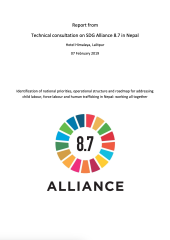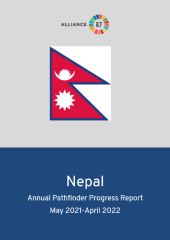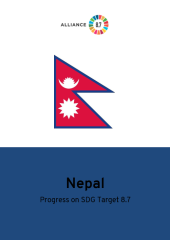Learn more about Nepal
Priorities
- Align federal laws related to child labour with national laws by 2019 and ensure coherence between child labour policies and education laws, in terms of children’s ages, to establish a coherent countrywide legal framework.
- Establish committees for child labour inspection at the provincial and local levels, to complement workplace inspection systems.
- Enhance monitoring capacity and establish local committees for child labour monitoring and rescue. Monitoring is critical for policy design; however it is often difficult, particularly in the informal economy.
- Declare ten child labour free municipalities by 2020, to serve as example for other municipalities.
- Revise the Foreign Employment Act of 2008, and other related acts, to eliminate loopholes that leave room for abuse.
- Establish bilateral agreements with destination countries to formalize a shared responsibility for labour recruitment issues and to protect migrant workers.
- Mainstream forced labour and human trafficking into regular data collection and integrate databases for an informed policy response.
- Establish labour committees and ensure their functioning needs.
- Map and constantly monitor high-risk groups to identify where interventions are most needed.
- Promote economic empowerment to reduce families’ vulnerabilities to forced labour and human trafficking.
- Create decent jobs in the country and strengthen employment promotion centers.
- Increase children’s access to quality education and strengthen vocational education to counter vulnerability due to low skills and lack of access to education.
Progress
- The Action Plan of the National Master Plan (NMP -II) has been approved and endorsed by the Ministry of Labour, Employment and Social Security (MoLESS) and it is being implemented.
- The provincial dialogue on Child Labour and Forced Labour is completed in six out of seven provinces. The district-level sensitization program was held during this reporting period.
- The Ministry of Land Management, Cooperatives and Poverty Alleviation (MOLCPA) has drafted Integrated Rehabilitation Procedure and Action Plan for the rehabilitation of the former bonded labour (freed Haliya, Kamaiya, Kamlari and Haruwa-Charuwa) with the technical assistance of ILO/Bridge Project.
- MoLESS has drafted an Integrated Forced Labour Act with the technical assistance of the ILO/Bridge Project.
- MoLESS developed IEC Materials together with ILO (Radio PSA on Child Labour in three languages, Posters, Policy Brief, TV PSAs).
- In the Nepali fiscal year (2021-22), in total 5771 children have received protection support from National Child Rights Council; 3795 among them were girls.
- 197 local levels (municipalities and rural municipalities) have assigned child welfare officers and among them, 180 local levels have established child funds.
- There is a local child rights committee at 206 local levels and child protection policies are in place at 290 local levels.
- The Nepal Police’s Anti-Trafficking Bureau has conducted capacity-building programs for its case investigation team and its community police sensitizes communities on a regular basis. This year, they have counselled 2481 people about the risk of trafficking.
- 145 human trafficking cases were registered with Nepal Police: 215 male and 76 female perpetrators were held.
- Regional Consultation on the Elimination of Child Labour was held in Nepal which was organized by the Ministry of Women, Children, and Senior Citizens, and the program was coordinated by National Action and Coordination Group (NACG). The program developed a regional strategy document, and it is in the consultation process for validation.
Align federal laws related to child labour with national laws by 2019 and ensure coherence between child labour policies and education laws, in terms of children’s ages, to establish a coherent countrywide legal framework.
- The definition of children has been harmonized in Child Act, 2018 and Child Labour (Prohibition and Regulation) Act, 2000 with the international definition of children as 18 years of age.
Establish committees for child labour inspection at the provincial and local levels, to complement workplace inspection systems.
- Committees to facilitate and coordinate child labour free local level are established in provincial and local level according to the arrangement made in Child Labour Free Local Level Guideline.
Enhance monitoring capacity and establish local committees for child labour monitoring and rescue Progress
- Capacity-building training of labour inspectors, representatives of local governments, employers and trade union were carried out.
Declare ten child labour-free municipalities by 2020, to serve as example for other municipalities. Progress
- Child Labour Free Municipalities Declaration Procedure, 2020 has been approved in December 2020.
Revise the Foreign Employment Act of 2008, and other related acts, to eliminate loopholes that leave room for abuse. Progress
- Foreign Employment Act has been revised.
Establish bilateral agreements with destination countries to formalize a shared responsibility for labour recruitment issues and to protect migrant workers.
- Bilateral agreement has been conducted with nine destination countries during this reporting period.
Mainstream forced labour and human trafficking into regular data collection and integrate databases for an informed policy response.
- Designing of unified database system is underway in Ministry of Women, Children and Senior Citizens incorporating data of human trafficking and gender related violence.
International Instruments
| Area | Ilo Instrument | Status | Ratification date | CEACR comments |
|---|---|---|---|---|
| Child Labour | C138 Ratification of C138 - Minimum Age Convention (1973) |
In Force | 30 May 1997 | |
| Child Labour, Forced Labour, Human Trafficking, Modern Slavery | C182 Worst Forms of Child Labour Convention (1999) |
In Force | 03 Jan 2002 | |
| Child Labour, Modern Slavery | C029 Forced Labour Convention (1930) |
In Force | 03 Jan 2002 | |
| Forced Labour, Human Trafficking, Modern Slavery | P029 Protocol of 2014 to the Forced Labour Convention (1930) |
|||
| Forced Labour, Modern Slavery | C105 Abolition of Forced Labour Convention (1957) |
In Force | 30 Aug 2007 | 2018 - Replies received to the issues raised in a direct request which do not give rise to further comments2018 - Replies received to the issues raised in a direct request which do not give rise to further comments2018 - Replies received to the issues raised in a direct request which do not give rise to further comments2018 - Replies received to the issues raised in a direct request which do not give rise to further comments2018 - Replies received to the issues raised in a direct request which do not give rise to further comments2018 - Replies received to the issues raised in a direct request which do not give rise to further comments2016 - Direct Request2016 - Direct Request2016 - Direct Request
|
| Child Labour, Forced Labour, Human Trafficking, Modern Slavery | C143 Migrant Workers (Supplementary Provisions) Convention (1975) |
|||
| Child Labour, Forced Labour, Human Trafficking, Modern Slavery | C181 Private Employment Agencies Convention (1997) |
|||
| Freedom of Association | C087 Freedom of Association and Protection of the Right to Organise Convention (1948) |
|||
| Freedom of Association | C098 Right to Organise and Collective Bargaining Convention (1949) |
In Force | 11 Nov 1996 | |
| Discrimination | C100 Equal Remuneration Convention (1951) |
In Force | 10 Jun 1976 | |
| Discrimination | C111 Discrimination (Employment and Occupation) Convention (1958) |
In Force | 19 Sep 1974 | |
| Occupational Safety and Health | C155 Occupational Safety and Health Convention (1981) |
|||
| Occupational Safety and Health | C187 Promotional Framework for Occupational Safety and Health Convention (2006) |
| Area | UN Treaty | Signature date | Ratification date | Status |
|---|---|---|---|---|
| Child Labour | IV-11 Convention on the Rights of the Child (1989) |
26 Jan 1990 | 14 Sep 1990 | |
| Child Labour | IV-11-c Optional Protocol to the Convention on the Rights of the Child on the sale of children, child prostitution and child pornography (2000) |
8 Sep 2000 | 20 Jan 2006 | |
| Forced Labour, Human Trafficking | PALERMO_PROTOCOL Protocol to Prevent, Suppress and Punish Trafficking in Persons, especially Women and Children, supplementing the United Nations Convention against Transnational Organized Crime (2000) |
16 Jun 2020 a | Accession | |
| Human Trafficking, Modern Slavery | XVIII-4 Ratification of the Supplementary Convention on the Abolition and of Slavery, the Slave Trade and Institutions and Practices Similar to Slavery (1956) |
7 Jan 1963 a | Accession |
RESOURCES

Nepal Strategic Workshop Report

Nepal - Pathfinder Country Progress Report, 2021-2022

Nepal - Pathfinder Country Progress Report, 2022 - 2023

Nepal - Pathfinder Country Progress Report, May - December 2023
